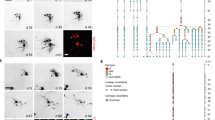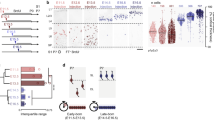Abstract
The mammalian brain maintains few developmental niches where neurogenesis persists into adulthood. One niche is located in the olfactory system where the olfactory bulb continuously receives functional interneurons. In vivo two-photon microscopy of lentivirus-labeled newborn neurons was used to directly image their development and maintenance in the olfactory bulb. Time-lapse imaging of newborn neurons over several days showed that dendritic formation is highly dynamic with distinct differences between spiny neurons and non-spiny neurons. Once incorporated into the network, adult-born neurons maintain significant levels of structural dynamics. This structural plasticity is local, cumulative and sustained in neurons several months after their integration. Thus, I provide a new experimental system for directly studying the pool of regenerating neurons in the intact mammalian brain and suggest that regenerating neurons form a cellular substrate for continuous wiring plasticity in the olfactory bulb.
This is a preview of subscription content, access via your institution
Access options
Subscribe to this journal
Receive 12 print issues and online access
$209.00 per year
only $17.42 per issue
Buy this article
- Purchase on Springer Link
- Instant access to full article PDF
Prices may be subject to local taxes which are calculated during checkout








Similar content being viewed by others
References
Lledo, P.M., Alonso, M. & Grubb, M.S. Adult neurogenesis and functional plasticity in neuronal circuits. Nat. Rev. Neurosci. 7, 179–193 (2006).
Ming, G.L. & Song, H. Adult neurogenesis in the mammalian central nervous system. Annu. Rev. Neurosci. 28, 223–250 (2005).
Altman, J. Autoradiographic and histological studies of postnatal neurogenesis. IV. Cell proliferation and migration in the anterior forebrain, with special reference to persisting neurogenesis in the olfactory bulb. J. Comp. Neurol. 137, 433–457 (1969).
Alvarez-Buylla, A. & Garcia-Verdugo, J.M. Neurogenesis in adult subventricular zone. J. Neurosci. 22, 629–634 (2002).
Kosaka, K. & Kosaka, T. Synaptic organization of the glomerulus in the main olfactory bulb: compartments of the glomerulus and heterogeneity of the periglomerular cells. Anat. Sci. Int. 80, 80–90 (2005).
Shepherd, G.M., Chen, W.R. & Greer, C.A. Olfactory Bulb in The Synaptic Organization of the Brain (ed. Shepherd, G.M.) 165–216 (Oxford University Press, New York, 2004).
Jung, J.C., Mehta, A.D., Aksay, E., Stepnoski, R. & Schnitzer, M.J. In vivo mammalian brain imaging using one- and two-photon fluorescence microendoscopy. J. Neurophysiol. 92, 3121–3133 (2004).
Mizrahi, A., Crowley, J.C., Shtoyerman, E. & Katz, L.C. High-resolution in vivo imaging of hippocampal dendrites and spines. J. Neurosci. 24, 3147–3151 (2004).
Mizrahi, A. & Katz, L.C. Dendritic stability in the adult olfactory bulb. Nat. Neurosci. 6, 1201–1207 (2003).
Rubin, B.D. & Katz, L.C. Optical imaging of odorant representations in the mammalian olfactory bulb. Neuron 23, 499–511 (1999).
Wachowiak, M. & Cohen, L.B. Representation of odorants by receptor neuron input to the mouse olfactory bulb. Neuron 32, 723–735 (2001).
Davenne, M., Custody, C., Charneau, P. & Lledo, P.M. In vivo imaging of migrating neurons in the Mammalian forebrain. Chem. Senses 30 Suppl 1: i115–i116 (2005).
Mizrahi, A., Lu, J., Irving, R., Feng, G. & Katz, L.C. In vivo imaging of juxtaglomerular neuron turnover in the mouse olfactory bulb. Proc. Natl. Acad. Sci. USA 103, 1912–1917 (2006).
Denk, W., Strickler, J.H. & Webb, W.W. Two-photon laser scanning fluorescence microscopy. Science 248, 73–76 (1990).
Petreanu, L. & Alvarez-Buylla, A. Maturation and death of adult-born olfactory bulb granule neurons: role of olfaction. J. Neurosci. 22, 6106–6113 (2002).
Carleton, A., Petreanu, L.T., Lansford, R., Alvarez-Buylla, A. & Lledo, P.M. Becoming a new neuron in the adult olfactory bulb. Nat. Neurosci. 6, 507–518 (2003).
Lee, W.C. et al. Dynamic remodeling of dendritic arbors in GABAergic interneurons of adult visual cortex. PLoS Biol. 4, e29 (2006).
Niell, C.M., Meyer, M.P. & Smith, S.J. In vivo imaging of synapse formation on a growing dendritic arbor. Nat. Neurosci. 7, 254–260 (2004).
Portera-Cailliau, C., Weimer, R.M., De Paola, V., Caroni, P. & Svoboda, K. Diverse modes of axon elaboration in the developing neocortex. PLoS Biol. 3, e272 (2005).
London, M. & Hausser, M. Dendritic computation. Annu. Rev. Neurosci. 28, 503–532 (2005).
Ziv, N.E. & Smith, S.J. Evidence for a role of dendritic filopodia in synaptogenesis and spine formation. Neuron 17, 91–102 (1996).
Dailey, M.E. & Smith, S.J. The dynamics of dendritic structure in developing hippocampal slices. J. Neurosci. 16, 2983–2994 (1996).
Maletic-Savatic, M., Malinow, R. & Svoboda, K. Rapid dendritic morphogenesis in CA1 hippocampal dendrites induced by synaptic activity. Science 283, 1923–1927 (1999).
Cooke, B.M. & Woolley, C.S. Gonadal hormone modulation of dendrites in the mammalian CNS. J. Neurobiol. 64, 34–46 (2005).
Gao, F.B., Kohwi, M., Brenman, J.E., Jan, L.Y. & Jan, Y.N. Control of dendritic field formation in Drosophila: the roles of flamingo and competition between homologous neurons. Neuron 28, 91–101 (2000).
Jan, Y.N. & Jan, L.Y. The control of dendrite development. Neuron 40, 229–242 (2003).
Williams, D.W. & Truman, J.W. Cellular mechanisms of dendrite pruning in Drosophila: insights from in vivo time-lapse of remodeling dendritic arborizing sensory neurons. Development 132, 3631–3642 (2005).
Wu, G.Y., Zou, D.J., Rajan, I. & Cline, H. Dendritic dynamics in vivo change during neuronal maturation. J. Neurosci. 19, 4472–4483 (1999).
Sin, W.C., Haas, K., Ruthazer, E.S. & Cline, H.T. Dendrite growth increased by visual activity requires NMDA receptor and Rho GTPases. Nature 419, 475–480 (2002).
Grutzendler, J., Kasthuri, N. & Gan, W.B. Long-term dendritic spine stability in the adult cortex. Nature 420, 812–816 (2002).
Holtmaat, A.J. et al. Transient and persistent dendritic spines in the neocortex in vivo. Neuron 45, 279–291 (2005).
Purves, D., Hadley, R.D. & Voyvodic, J.T. Dynamic changes in the dendritic geometry of individual neurons visualized over periods of up to 3 months in the superior cervical ganglion of living mice. J. Neurosci. 6, 1051–1060 (1986).
Trachtenberg, J.T. et al. Long-term in vivo imaging of experience-dependent synaptic plasticity in adult cortex. Nature 420, 788–794 (2002).
Zuo, Y., Lin, A., Chang, P. & Gan, W.B. Development of long-term dendritic spine stability in diverse regions of cerebral cortex. Neuron 46, 181–189 (2005).
Ailles, L.E. & Naldini, L. HIV-1–derived lentiviral vectors. Curr. Top. Microbiol. Immunol. 261, 31–52 (2002).
Trono, D. Lentiviral vectors: turning a deadly foe into a therapeutic agent. Gene Ther. 7, 20–23 (2000).
Feng, G. et al. Imaging neuronal subsets in transgenic mice expressing multiple spectral variants of GFP. Neuron 28, 41–51 (2000).
Dittgen, T. et al. Lentivirus-based genetic manipulations of cortical neurons and their optical and electrophysiological monitoring in vivo. Proc. Natl. Acad. Sci. USA 101, 18206–18211 (2004).
Kasthuri, N. & Lichtman, J.W. Structural dynamics of synapses in living animals. Curr. Opin. Neurobiol. 14, 105–111 (2004).
Saghatelyan, A. et al. Activity-dependent adjustments of the inhibitory network in the olfactory bulb following early postnatal deprivation. Neuron 46, 103–116 (2005).
Burrone, J., O'Byrne, M. & Murthy, V.N. Multiple forms of synaptic plasticity triggered by selective suppression of activity in individual neurons. Nature 420, 414–418 (2002).
Katz, L.C. & Shatz, C.J. Synaptic activity and the construction of cortical circuits. Science 274, 1133–1138 (1996).
Lledo, P.M. & Saghatelyan, A. Integrating new neurons into the adult olfactory bulb: joining the network, life-death decisions, and the effects of sensory experience. Trends Neurosci. 28, 248–254 (2005).
Sawamoto, K. et al. New neurons follow the flow of cerebrospinal fluid in the adult brain. Science 311, 629–632 (2006).
Ghashghaei, H.T., Lai, C. & Anton, E.S. Neuronal migration in the adult brain: are we there yet? Nat. Rev. Neurosci. 8, 141–151 (2007).
Belluzzi, O., Benedusi, M., Ackman, J. & LoTurco, J.J. Electrophysiological differentiation of new neurons in the olfactory bulb. J. Neurosci. 23, 10411–10418 (2003).
Spitzer, N.C. Electrical activity in early neuronal development. Nature 444, 707–712 (2006).
Knott, G.W., Holtmaat, A., Wilbrecht, L., Welker, E. & Svoboda, K. Spine growth precedes synapse formation in the adult neocortex in vivo. Nat. Neurosci. 9, 1117–1124 (2006).
Bozza, T., Feinstein, P., Zheng, C. & Mombaerts, P. Odorant receptor expression defines functional units in the mouse olfactory system. J. Neurosci. 22, 3033–3043 (2002).
Sholl, D.A. Dendritic organization in the neurons of the visual and motor cortices of the cat. J. Anat. 87, 387–406 (1953).
Acknowledgements
I thank Y. Finelt for technical help and P. Mombaerts for the M71-GFP mice. I thank I. Segev, Y. Yarom, S. Wagner, I. Davison and members of my lab for critically reading early versions of the manuscript. Special thanks to S. Wagner for the intracellular labeling of PGNs. A.M. is supported by a Career Development Award from the International Human Frontier Science Program Organization and by ISF grant # 313–05.
Author information
Authors and Affiliations
Corresponding author
Ethics declarations
Competing interests
The author declares no competing financial interests.
Supplementary information
Supplementary Fig. 1
GFP expressing cells in the OB are neurons, not glia. (PDF 922 kb)
Supplementary Fig. 2
Comparison of labeling patterns of GFP and BrdU. (PDF 1117 kb)
Supplementary Fig. 3
PGN arrival to the glomerular layer decreases with increasing durations after virus injection. (PDF 698 kb)
Supplementary Fig. 4
Morphology of randomly selected PGNs. (PDF 225 kb)
Supplementary Fig. 5
In vivo imaging of adult born PGNs 45 days apart. (PDF 637 kb)
Supplementary Fig. 6
Examples of adult-born PGNs during early development. (PDF 215 kb)
Supplementary Fig. 7
Comparison between in vivo and fixed tissue. (PDF 187 kb)
Rights and permissions
About this article
Cite this article
Mizrahi, A. Dendritic development and plasticity of adult-born neurons in the mouse olfactory bulb. Nat Neurosci 10, 444–452 (2007). https://doi.org/10.1038/nn1875
Received:
Accepted:
Published:
Issue Date:
DOI: https://doi.org/10.1038/nn1875
This article is cited by
-
Young adult-born neurons improve odor coding by mitral cells
Nature Communications (2020)
-
Neural plasticity in developing and adult olfactory pathways – focus on the human olfactory bulb
Journal of Bioenergetics and Biomembranes (2019)
-
Developmental exposure of decabromodiphenyl ether impairs subventricular zone neurogenesis and morphology of granule cells in mouse olfactory bulb
Archives of Toxicology (2018)
-
Single-cell analysis of diversity in human stem cell-derived neurons
Cell and Tissue Research (2018)
-
The Potential of Stem Cells in Treatment of Traumatic Brain Injury
Current Neurology and Neuroscience Reports (2018)



